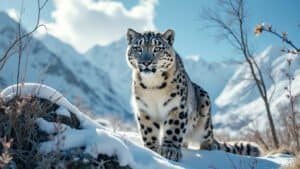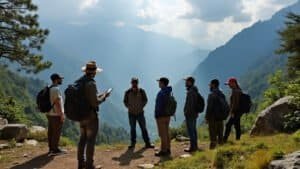Introduction
Snow leopards are elusive creatures native to the high-altitude regions of Central and South Asia. These majestic animals are critically endangered, with fewer than 7,000 remaining in the wild. Awareness campaigns play a crucial role in their survival, aiming to inform the public, promote conservation strategies, and engage local communities in protecting these beautiful cats
This article will explore the importance of these campaigns, the key strategies they promote, and the role of education in fostering a global movement for snow leopard conservation
Additionally, we’ll examine how these campaigns measure success and overcome the challenges they face in safeguarding this iconic species
Importance of Snow Leopard Awareness Campaigns
Snow leopards, with their striking appearance and elusive nature, have become a symbol of the fragile balance between wildlife and the environment. Despite their mystique, these magnificent animals face numerous threats, including habitat loss, poaching, and climate change
Awareness campaigns are vital in bringing attention to these issues, fostering a global understanding of the snow leopard’s plight, and encouraging actions that contribute to their survival
Why Snow Leopard Conservation Matters
Snow leopards are top predators in their ecosystem, playing a crucial role in maintaining the balance of the habitats they occupy. Their presence helps regulate prey populations, which in turn influences the health of the entire ecosystem
When snow leopards are threatened, the ripple effect can destabilize the biodiversity of their environment. This makes their conservation not only about saving a species but also about preserving the delicate ecological balance in the mountainous regions of Central and South Asia
Moreover, snow leopards are an indicator species; their well-being reflects the overall health of the high-altitude environments they inhabit
Protecting snow leopards means protecting a wide range of other species that share their habitat, from other mammals to birds and plants. The loss of snow leopards could signal the beginning of a broader ecological collapse, highlighting the urgency of conservation efforts
Impact of Public Awareness on Snow Leopard Survival
Public awareness is a powerful tool in conservation. When people are informed about the threats facing snow leopards, they are more likely to support initiatives aimed at protecting these animals
Awareness campaigns serve to educate the public about the causes and consequences of snow leopard endangerment, from poaching to habitat destruction. These campaigns often highlight the interconnectedness of global ecosystems, showing how the decline of snow leopards can have far-reaching effects
Effective awareness campaigns can lead to increased funding for conservation projects, stronger wildlife protection laws, and greater public participation in conservation efforts
For instance, organizations like the Snow Leopard Trust use awareness campaigns to gather support for their work, which includes community-based conservation programs, research, and anti-poaching initiatives. The visibility generated by these campaigns can also lead to partnerships with governments, NGOs, and the private sector, all of which are crucial for long-term conservation success
The Role of Global Awareness in Protecting Endangered Species
Global awareness campaigns are instrumental in bringing the plight of snow leopards to the international stage. These campaigns leverage media, social platforms, and global events to spread the message about snow leopard conservation. By engaging audiences worldwide, they create a unified voice calling for the protection of these endangered cats
International attention can pressure governments to implement and enforce stronger conservation policies and can encourage multinational cooperation on issues like habitat preservation and anti-poaching efforts
For example, World Wildlife Day and International Snow Leopard Day are opportunities to focus global attention on the challenges facing snow leopards
These events mobilize millions of people across different countries, fostering a sense of global responsibility towards protecting snow leopards and their habitats. Through these efforts, awareness campaigns not only raise knowledge but also inspire action, from individual donations to large-scale conservation partnerships
Key Conservation Strategies Promoted
The survival of snow leopards depends on a multi-faceted approach to conservation. Awareness campaigns play a crucial role in highlighting and promoting these strategies, ensuring that efforts are well-coordinated and effective across the regions where snow leopards live
These campaigns focus on protecting the natural habitats of snow leopards, preventing poaching, and involving local communities in conservation activities
Habitat Protection and Restoration
Snow leopards are native to the rugged, high-altitude regions of Central and South Asia, spanning 12 countries including China, India, and Mongolia
However, their habitat is increasingly under threat due to human activities such as agriculture, mining, and infrastructure development. Awareness campaigns emphasize the importance of habitat protection, advocating for the preservation of vast tracts of land that are crucial for the survival of snow leopards
One significant initiative is the creation of protected areas and wildlife corridors that allow snow leopards to roam freely across large territories
For example, the Global Snow Leopard and Ecosystem Protection Program (GSLEP), launched in 2013, aims to secure at least 20 snow leopard landscapes by 2020. This initiative highlights the need for international cooperation in creating and maintaining protected areas that transcend national borders
Restoration of degraded habitats is another key focus. Campaigns promote reforestation efforts and the rehabilitation of damaged ecosystems to ensure that snow leopards have access to the prey and resources they need
These restoration efforts often involve collaboration between conservationists, governments, and local communities, all working together to restore the natural environment
Anti-Poaching Initiatives
Poaching remains one of the most significant threats to snow leopards. These animals are hunted for their fur, bones, and other body parts, which are highly valued on the black market. Awareness campaigns shine a light on the devastating impact of poaching, not only on snow leopard populations but also on the broader ecosystem
Anti-poaching initiatives are a central theme in many campaigns. These initiatives include increasing the number of patrols in snow leopard habitats, improving law enforcement to catch and prosecute poachers, and raising awareness about the illegal wildlife trade
Technology also plays a role, with campaigns supporting the use of camera traps, satellite tracking, and other tools to monitor snow leopard populations and track poaching activities
Educational efforts are equally important. By informing local communities about the consequences of poaching and the legal protections for snow leopards, campaigns help to reduce the demand for illegal wildlife products
Programs that offer alternative livelihoods to those who might otherwise engage in poaching are also promoted, providing sustainable economic opportunities that do not harm snow leopards
Community-Based Conservation Efforts
Local communities living in snow leopard habitats are key stakeholders in conservation efforts. Awareness campaigns stress the importance of involving these communities in conservation strategies, recognizing that their support is essential for the long-term survival of snow leopards
One approach promoted by campaigns is the development of community-based conservation programs. These programs often include training local people as wildlife rangers, who can monitor snow leopard populations and deter poaching
In regions like Kyrgyzstan and Nepal, such initiatives have led to a significant reduction in poaching incidents and increased sightings of snow leopards
Sustainable livelihood programs are another focus. Campaigns advocate for initiatives that provide economic incentives for communities to protect snow leopards rather than hunt them. For example, eco-tourism projects that offer income through wildlife tourism can turn snow leopards into a valuable resource worth preserving
Additionally, livestock insurance schemes and predator-proof corrals are promoted to mitigate conflicts between snow leopards and herders, ensuring that snow leopards are seen as a benefit rather than a threat to local livelihoods
Engagement of Local Communities
The involvement of local communities is a cornerstone of effective snow leopard conservation. Awareness campaigns recognize that the people living in and around snow leopard habitats are crucial to the success of conservation efforts
By fostering community engagement, these campaigns aim to build a sense of stewardship among locals, ensuring that they become active participants in the protection of snow leopards
Educating Local Populations About Snow Leopard Protection
Education is a powerful tool in conservation. Awareness campaigns place a strong emphasis on educating local populations about the importance of snow leopard conservation. This education often includes information about the ecological role of snow leopards, the threats they face, and the benefits of preserving them
In many snow leopard regions, traditional knowledge and cultural beliefs play a significant role in how wildlife is perceived. Campaigns often work to align conservation goals with local cultural values, making the protection of snow leopards a matter of pride and identity for the community
For example, in Mongolia, the Snow Leopard Trust collaborates with local herders, educating them about the importance of snow leopards to the environment and the steps they can take to protect these animals
Workshops, school programs, and community meetings are common methods used to spread knowledge. These educational initiatives are designed to reach people of all ages, ensuring that both current and future generations understand the significance of conserving snow leopards
Sustainable Livelihood Programs for Snow Leopard Habitats
One of the main challenges in snow leopard conservation is the potential for conflict between these predators and the people who share their environment
Snow leopards sometimes prey on livestock, which can lead to economic losses for herders. Awareness campaigns address this issue by promoting sustainable livelihood programs that provide alternatives to practices that harm snow leopards
Livestock insurance schemes are one such initiative. These programs compensate herders for livestock lost to snow leopard predation, reducing the financial burden and the motivation to retaliate against the cats
Another approach is the construction of predator-proof corrals, which protect livestock at night, when snow leopards are most likely to attack. These measures not only reduce conflicts but also foster goodwill towards conservation efforts
Eco-tourism is another sustainable livelihood strategy promoted by awareness campaigns. By developing eco-tourism ventures, communities can generate income from wildlife-friendly activities such as guided snow leopard tracking tours. This not only provides a financial incentive to protect snow leopards but also raises awareness among tourists about the importance of conservation
Collaborative Efforts Between Conservationists and Local Residents
Collaboration between conservationists and local residents is essential for the long-term success of snow leopard conservation. Awareness campaigns highlight the importance of involving communities in the planning and implementation of conservation strategies, ensuring that their needs and concerns are addressed
Community-based conservation initiatives often involve training local people to become wildlife rangers or conservation officers
These individuals play a critical role in monitoring snow leopard populations, protecting habitats, and preventing poaching. Their intimate knowledge of the landscape and wildlife makes them invaluable allies in the fight to protect snow leopards
In regions like the Himalayas, collaborative efforts have led to the establishment of community-managed conservation areas, where local residents take the lead in protecting snow leopard habitats. These areas serve as models of how conservation and community development can go hand in hand, benefiting both people and wildlife
The success of these collaborative efforts is often celebrated in awareness campaigns, which share stories of communities that have become champions of snow leopard conservation. By showcasing these successes, campaigns inspire other communities to follow suit, creating a network of grassroots conservation efforts across snow leopard habitats
The Role of Education in Conservation
Education is one of the most powerful tools in the fight to save snow leopards from extinction
Awareness campaigns emphasize the importance of educating the public, particularly in regions where snow leopards live, as well as engaging the global community to foster a deeper understanding of the issues surrounding snow leopard conservation
By increasing knowledge and awareness, these campaigns aim to inspire action and drive long-term commitment to protecting this endangered species
Raising Awareness Through Schools and Universities
Incorporating snow leopard conservation into educational curricula is a key strategy for awareness campaigns. By reaching students at various educational levels, from primary schools to universities, campaigns can instill a sense of responsibility towards wildlife conservation from an early age
Educational programs often include lessons on the biology and ecology of snow leopards, the importance of biodiversity, and the specific threats that these animals face
For instance, in countries like Nepal and India, conservation organizations work with schools located near snow leopard habitats to educate children about the significance of these big cats
These programs often involve interactive activities such as wildlife clubs, where students participate in conservation projects, nature walks, and art competitions focused on snow leopards. By engaging young minds, these efforts help to cultivate future conservationists who will continue to advocate for snow leopards and their ecosystems
At the university level, partnerships between conservation organizations and academic institutions lead to research opportunities that contribute to the scientific understanding of snow leopards
Students and researchers collaborate on field studies, which provide valuable data for conservation planning. These academic partnerships also help to train the next generation of conservation scientists, equipping them with the skills and knowledge needed to address complex conservation challenges
Public Outreach and Media Campaigns
Public outreach is an essential component of snow leopard awareness campaigns
These efforts aim to educate the broader public about snow leopard conservation, often through the use of media such as television, radio, social media, and print publications. By leveraging various forms of media, campaigns can reach a wide audience and generate support for conservation initiatives
Social media platforms play a particularly important role in raising awareness globally. Campaigns often use platforms like Facebook, Instagram, and Twitter to share stories, images, and videos that highlight the beauty of snow leopards and the urgent need for their protection
Hashtags like #SaveOurSnowLeopards and #SnowLeopardDay are used to create a sense of community and encourage people to share their own messages of support
Documentaries and television programs are also powerful tools for public outreach. Films like Vanishing Kings: Lions of the Namib or Planet Earth have brought the plight of endangered species, including snow leopards, into the living rooms of millions of viewers worldwide. These visual narratives not only educate but also emotionally engage audiences, motivating them to take action
Print publications, such as books, articles, and educational pamphlets, are distributed in areas where snow leopards are found, providing detailed information on how local communities can participate in conservation efforts
These materials often include practical advice on coexisting with snow leopards, such as how to protect livestock or report sightings to conservation authorities
The Importance of Youth Involvement in Snow Leopard Conservation
Youth involvement is critical for the long-term success of snow leopard conservation efforts. Young people are the future stewards of the planet, and their engagement in conservation activities is essential for ensuring the continued protection of snow leopards
Awareness campaigns focus on empowering youth to take an active role in conservation through education, participation in community projects, and leadership opportunities
Programs such as youth conservation clubs and environmental education camps are designed to inspire young people to become advocates for snow leopards
These initiatives provide hands-on learning experiences, where youth can participate in activities like tracking snow leopards, monitoring wildlife, and conducting surveys. By directly involving them in conservation work, these programs help to develop a deep connection to nature and a strong commitment to protecting it
Youth leadership is also promoted through awareness campaigns. Young leaders are encouraged to organize events, lead community outreach efforts, and participate in decision-making processes related to conservation
These opportunities not only build leadership skills but also ensure that the voices of young people are heard in the global conversation on snow leopard conservation
By focusing on education and youth involvement, awareness campaigns lay the foundation for a future where snow leopards and other endangered species are protected by informed and passionate conservationists. These efforts are crucial for sustaining the momentum of conservation initiatives and ensuring that the next generation is prepared to continue the work of protecting snow leopards and their habitats
Measuring Success and Overcoming Challenges
Effective snow leopard conservation requires not only implementing strategies but also measuring their success and addressing the challenges that arise
Awareness campaigns play a pivotal role in highlighting the importance of tracking progress, adapting strategies, and overcoming obstacles to ensure the long-term survival of snow leopards
Metrics Used to Assess Campaign Impact
One of the key aspects of any conservation effort is the ability to measure its impact. Awareness campaigns emphasize the use of specific metrics to assess the effectiveness of conservation strategies
These metrics include population counts, the number of poaching incidents, and the extent of protected habitats. By monitoring these indicators, conservationists can gauge the success of their efforts and make informed decisions about where to focus resources
Population monitoring is one of the most direct metrics used. Through the use of camera traps, DNA analysis, and field surveys, conservationists track changes in snow leopard populations over time. An increase in population size or stabilization in previously declining areas is a positive indicator of successful conservation
For example, in the Tost Mountains of Mongolia, the Snow Leopard Trust has successfully used camera traps to monitor a growing population of snow leopards, which indicates that conservation efforts in the area are working
Another critical metric is the reduction in human-wildlife conflicts, particularly those involving livestock predation. By tracking incidents where snow leopards prey on livestock and the subsequent actions taken by herders, conservationists can measure the effectiveness of conflict mitigation strategies, such as predator-proof corrals or compensation schemes
Additionally, the expansion of protected areas and wildlife corridors is a significant measure of success. The creation and maintenance of these areas are vital for providing snow leopards with the space they need to roam and hunt
Campaigns often measure the area of land under protection and monitor the enforcement of regulations within these zones to ensure that snow leopards are truly safe
Challenges Faced by Awareness Campaigns
Despite the successes, snow leopard awareness campaigns face numerous challenges that can hinder their effectiveness. One of the most significant challenges is securing adequate funding
Conservation efforts, particularly in remote and rugged areas where snow leopards live, are expensive. Funds are needed for research, community outreach, anti-poaching patrols, and habitat restoration. Limited financial resources can restrict the scope and impact of awareness campaigns
Another challenge is political and legal obstacles. Snow leopard habitats often span multiple countries, each with its own set of laws and regulations regarding wildlife protection. Campaigns must navigate these complex legal landscapes, advocating for stronger protections and better enforcement
Additionally, political instability in some regions can disrupt conservation efforts, making it difficult to maintain consistent progress
Climate change presents another formidable challenge. The impacts of global warming, such as melting glaciers and changing weather patterns, are already affecting the high-altitude ecosystems where snow leopards live
As their habitat shifts, snow leopards may be forced into closer contact with human populations, increasing the likelihood of conflict. Awareness campaigns must address the broader issue of climate change while continuing to focus on immediate conservation needs
Public apathy or lack of awareness is also a significant hurdle. In regions far removed from snow leopard habitats, the plight of these animals may not seem urgent or relevant to people’s daily lives. Campaigns must work hard to connect the fate of snow leopards with broader environmental and ethical concerns, encouraging global audiences to care about and support conservation efforts
Adapting Strategies to Ensure Long-Term Success
To overcome these challenges and ensure long-term success, awareness campaigns must be adaptable and innovative
One approach is to diversify funding sources by engaging with corporate sponsors, international donors, and public fundraising efforts. Crowdfunding campaigns and partnerships with businesses that support conservation can provide much-needed financial support
Campaigns can also benefit from leveraging new technologies. For instance, the use of satellite imagery and drones for habitat monitoring offers more efficient ways to track changes in snow leopard territories. Mobile apps and online platforms can be used to engage the public, providing real-time updates on conservation efforts and enabling people to contribute directly to specific projects
Collaboration is another key to success. By working closely with governments, NGOs, local communities, and international organizations, awareness campaigns can pool resources, share knowledge, and coordinate efforts across borders
These partnerships are especially important in addressing challenges that require large-scale, cooperative solutions, such as habitat fragmentation and climate change
Finally, raising public awareness and fostering global advocacy are essential for maintaining momentum. By keeping the issue of snow leopard conservation in the public eye, campaigns can build a broad base of support that includes not only environmentalists but also policymakers, businesses, and the general public. This broad support is crucial for ensuring that snow leopard conservation remains a priority for years to come
Conclusion
Snow leopards are iconic creatures whose survival depends on the combined efforts of global awareness, community engagement, and robust conservation strategies. Awareness campaigns play a crucial role in highlighting the importance of protecting these endangered animals by promoting key conservation initiatives, such as habitat protection, anti-poaching measures, and community-based programs
Education is central to these efforts, ensuring that both local populations and the broader public understand the significance of snow leopard conservation. Despite the challenges these campaigns face, such as securing funding and addressing climate change, they continue to adapt and innovate to ensure long-term success
By measuring their impact and overcoming obstacles, these campaigns contribute significantly to safeguarding the future of snow leopards and the ecosystems they inhabit. The continued support and involvement of people worldwide are vital to maintaining the momentum needed to protect these majestic animals for generations to come








